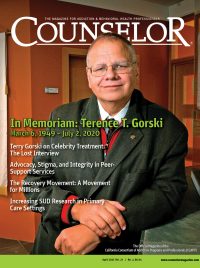Share
The opioid crisis has reached every corner of the United States, with no community left unscathed from devastating loss of life and productivity caused by opioid overdoses and opioid use disorder (OUD). In 2017, 20.7 million people in the US were estimated to have at least one substance use disorder (SUD), yet over 80 percent of them did not receive any substance use treatment in the past year (SAMHSA, 2018). A total of 67,367 drug overdose deaths occurred in 2018 in the United States, with nearly 70 percent involving any type of opioid and roughly half of those involving a prescription opioid (Scholl, Seth, Kariisa, Wilson, & Baldwin, 2019; Wilson, Kariisa, Seth, Smith, & Davis, 2020).
Primary care providers (PCPs) are on the front line of our health care system, and they provide first-line treatment for pain, including the prescription of opioid medications. They are responsible for writing half of all opioid prescriptions each year and over 20 percent of the individuals for whom they write those prescriptions have evidence of OUDs (Von Korff et al., 2017). Even though the problem is serious and widespread, a significant portion of SUDs go unrecognized. One survey of patients in ten substance use treatment facilities in four states found that 43 percent said their PCPs did not diagnose their SUDs (CASA, 2000).
Why SUD Research is Important in Primary Care Settings
Prevention, identification, and treatment of SUDs is essential to end the epidemic facing communities across the nation, and those efforts must meet patients where they are. PCPs serve every community; they are the cornerstone of our health care delivery system and often the first contact patients have with the health system. They are experts in comprehensive preventative care, screening, and continuing care for a multitude of conditions. Patients are more likely to see PCPs than any other specialty, with half of all physician office visits in 2018 made to primary care (PC) clinics (CDC, 2019). Patients also often have longstanding relationships with providers and clinics, with the overwhelming majority of adults (86 percent) reporting a usual source of medical care in 2016 (Ashman, Rui, & Okeyode, 2019). PCPs have the access, the skill, and the rapport with patients to optimally support prevention, identification, and treatment of SUDs, evidenced by patients expressing that they are 50 percent more willing to engage in substance use therapies in PC settings than in specialty drug treatment centers (Barry, Epstein, Fiellin, Fraenkel, & Busch, 2016).
Working with PC clinics and PCPs is an essential step in effective PC research and PC interventions. Practice-based research networks (PBRNs) are ideal facilitators of that work, as they include PCPs and PC practices committed to answering health care questions of interest and importance to their patients and communities. PBRNs are diverse, including community health centers, private practices, academic- and health-system-affiliated practices, and government-operated clinics. At the same time, PBRNs are united in their belief that effective PC research must partner with PC settings and their PCPs. Since these networks engage providers in their own practices, interventions can be more effective, as they are developed with clinic conditions and constraints in mind, thus ameliorating the challenges of developing appropriate interventions and translating them into practice (AHRQ, n.d.; Baldwin et al., 2012; Carey, Halladay, Donahue, & Cykert, 2015; Tapp & Dulin, 2010; Westfall, Mold, & Fagnan, 2007).
The National Drug Abuse Treatment Clinical Trials Network (CTN) recognizes the importance of PBRNs in generating, implementing, and disseminating research evidence that supports optimal management of patients with SUDs in PC settings. In 2014, the CTN published a funding announcement calling on its regional research centers, or “nodes,” to partner with PBRNs (HHS, 2009; HHS, 2015; Tai, Sparenborg, Ghitza, & Liu, 2014). Since its inception, the CTN has focused on promoting research in community-based treatment settings, where most patients receive care, in response to the slow integration of evidence-based practices into SUD treatment (CDC, 2018; Tai, Sparenborg, Liu, & Straus, 2011). Promoting research partnerships with PBRNs is an extension of those efforts to meet patients where they are. These collaborations allow interventions to be studied in varied settings, with diverse patient populations, while also increasing the acceptability, feasibility, and translatability of evidence-based treatments into these settings (NIDA, 2015).
One survey of patients in ten substance use treatment facilities in four states found that 43 percent said their PCPs did not diagnose their SUDs.
Understanding the Magnitude of Opioid Prescribing in Primary Care
The CTN supports infrastructure to develop, test, and disseminate various treatment options for SUDs in a variety of settings (NIDA, 2015). CTN affiliations with PBRNs support PBRN infrastructure and expose SUD investigators to opportunities to conduct research in varied PC settings that serve diverse patient populations. Incidentally, these affiliations have also led to opportunities for networking and collaboration amongst PBRNs that share an affinity for SUD research. A recently published article described one such collaboration between seven PBRNs across the US (Baldwin et al., 2020). The authors—CTN- and PBRN-affiliated researchers—sought to better understand clinics’ current practices in preventing, diagnosing, and treating SUDs and their barriers to implementing evidence-based SUD interventions. These CTN- and PBRN-affiliated researchers developed a research project that sought to answer questions of importance to both PC clinics and SUD researchers about opioid prescribing practices and policies, and to demonstrate the ability of multiple PBRNs across the CTN to collaborate on SUD research in PC settings. The collaboration with several PBRN-affiliated providers facilitated first the study team’s identification of questions that are important to opioid management in real-world clinical care, and second the development of research methods that were appropriate for busy clinical settings and could be translated across diverse sites. The study included a survey of prescribing policies, procedures, and practices, and an electronic health record (EHR) query of annual rates of opioid and sedative medication prescribing, which was simple enough to encourage participation regardless of clinics’ level of technical sophistication.
The combination of EHR and survey data allowed the study team and associated PBRNs and practices to obtain a more comprehensive picture of opioid prescribing. Understanding prescribing rates in the context of associated processes, policies, and practices helps elucidate where clinics’ strengths and weaknesses lie, and provides a foundation for future research, quality improvement efforts, and ultimately improving care for patients with SUDs.
The EHR data represented over half a million adult patients, from eighty-four clinics in six PBRNs, who had an office visit during the one-year project period. Of these patients, over one fifth were prescribed at least one opioid medication in the project year. The authors found these prescribing rates to be double that of a another study that used data from PC clinics at one PBRN during a similar time period (Tong et al., 2019). The authors also found that potential concurrent opioid-sedative prescription orders amongst their sample were more than double national figures (Jeffery et al., 2019). These data indicate that there is substantial opportunity to affect meaningful improvement in patient care for thousands of patients within CTN-affiliated PBRNs by implementing evidence-based tools and practices and researching interventions for improving opioid management in PC settings.
The high rates of opioid prescription and potential concurrent opioid-sedative prescription indicate that these clinics and others would be ideal partners in research that addresses prevention, screening, and treatment.

The survey component of the project sought to look at processes, policies, and practices that have been recommended to support responsible opioid prescribing (Dowell, Haegerich, & Chou, 2016; MCHP, 2018). A total of fifty-eight clinic leaders from seven PBRNs completed surveys on behalf of their clinics. The overwhelming majority of clinics reported having formal chronic opioid therapy treatment agreements, provider access to state prescription monitoring program information, and a urine drug testing policy. Most clinics had written policies for opioid prescribing and for checking the prescription drug monitoring program. Fewer than half of clinics provided reports to providers with feedback on opioid management, and about a third had a random pill-count policy or a registry for tracking patients using chronic opioid therapy. Notably, all clinics reported that while they may have the aforementioned policies and procedures in place, they were less likely to follow them consistently.
This project was able to accomplish a relatively untested feat. The cooperating PBRNs were able to share data that represented hundreds of thousands of patients in highly diverse PC practices nationally. This project is one of only a few other examples of data sharing across such diverse practice types and geography (DeVoe et al., 2012; Fiks et al., 2015; Lin et al., 2010; Pace et al., 2009). PC practices offer immense opportunities for research that has the potential for generalizability and clinical applicability, and PBRNs are an accessible way for researchers to engage these settings.
PBRNs are organized networks with research offices that help facilitate research within the affiliated practices. PBRN research offices were critical to this study’s success. By developing research methods and procedures that were appropriate for clinical practice and performing research tasks such as facilitating IRB approval, distributing and collecting surveys, and training clinic personnel on the EHR query, the PBRN research offices were able to minimize the burden to sites, enabling participation. PBRN research offices have a long history of supporting partnerships with diverse clinical settings and academic investigators (Berlowitz et al., 2017; Cené et al., 2017; Cole, Keppel, Andrilla, Cox, & Baldwin, 2016; Dolor, Schmit, Graham, Fox, & Baldwin, 2014; Heintzman et al., 2014; Ludden et al., 2019; Robins et al., 2013; Young et al., 2017). The CTN’s support of PBRNs strengthens these network resources and exposes researchers to more opportunities to work in diverse real-world settings.
PBRNs Can Help to Reduce Research Challenges
While this project was able to answer an important question in SUD research and demonstrate the power of PBRNs to engage with their practices and each other, it was not without limitations. All participants, researchers, and clinics volunteered to participate in this study with no additional funding, thus much of the sample was based on convenience and is not representative of the PBRNs as a whole. Due to the complex and expensive nature of EHR data extraction, the research team developed a simple query that enabled clinics to participate in this portion of the project with limited resources. The simplicity of this query did not allow for distinction between chronic opioid therapy and acute treatment of pain, nor did it allow the study team to confirm that opioid and sedative prescriptions were truly concurrent, only that they were ordered in the same year. The authors note that a fully-funded study would have facilitated increased recruitment efforts to include a more representative sample, and to enhance likelihood of clinic participation through incentives. Dedicated funding also would have allowed them to address these limitations through the creation of a centralized patient- and provider-level database with full quality controls, harmonization of variables, and inclusion of a larger number of study variables. The authors also note that their demonstration project was not designed to illustrate the full capacity of the PBRNs to conduct in-depth analyses with their EHR data. Instead, it was designed to showcase the opportunity that PBRNs present as resources and partners in future research.
Even though conducting research in PC settings is crucial for scientific discovery and the dissemination of evidence-based practices, it remains challenging. Community-based PC clinics’ primary role is to serve the day-to-day medical needs of their patients. Few clinics have research infrastructure or dedicated staff to support research, and clinics and their personnel have many competing priorities. These challenges can make study participation difficult for clinics. PBRN research offices help ensure that researchers design and conduct research with real-world clinic conditions in mind, so research is feasible for busy community settings. This not only encourages clinic participation, but it also helps ensure that scientific discovery is generalizable to the community-based clinics where most people get their care. In the demonstration project highlighted herein, PBRNs were able to leverage their trusting relationships with clinical partners to engage clinics in research that was important to them. The methods, procedures, and training protocols were designed to have minimal impact on clinical sites. Although there was no dedicated funding for this project, all PBRNs were able to deliver the EHR query, and all but one delivered survey results, something that would not have been possible without the existing PBRN infrastructures and relationships.
Leveraging Research to Build Stronger Connections and a Stronger Resource
CTN-affiliated PBRNs capitalized on the connections formed during the project and have since formed a PBRN special interest group (SIG) that brings together CTN-affiliated PBRNs and investigators interested in substance use research in PC settings (Baldwin & Dolor, n.d.). The SIG was designed to build on PBRN collaborations in order to develop substance use treatment interventions relevant to community-based practices; to expand the number of research proposals relevant to and engaging PC practices; and to increase the ability of community-based practices to participate in CTN and SUD studies. The SIG is also a resource for investigators interested in substance use research in PC settings. Since the SIG brings together CTN-affiliated PBRNs from across the US, investigators have the opportunity to connect with a wide range of practice types with diverse populations in disparate locations. SIG members are experts in practice-based research, and they can provide investigators with consultation on project development, methods, study design, and recruitment processes to ensure compatibility with community-based practices. SIG members share their extensive expertise to improve the acceptability and appropriateness of SUD research and dissemination in community-based settings while also enhancing investigators’ access to these settings and their ability to work in them.
The demonstration project described in this article shows that there are great opportunities to improve patient care in the many clinics within CTN-affiliated PBRNs and beyond. The high rates of opioid prescription and potential concurrent opioid-sedative prescription indicate that these clinics and others would be ideal partners in research that addresses prevention, screening, and treatment. By meeting patients where they are, researchers are better able to understand the current landscape and develop interventions that are most suitable. PBRNs serve as indispensable resources to facilitate this work, as demonstrated by the efforts of those described to develop and implement this project in multiple clinics across diverse organizations. While collaborating with community-based settings in research is not without its challenges, it is critical for understanding and responding to patients with SUDs. Institutional support of PBRNs, by the CTN and others, facilitates the inclusion of these community-based clinics in research.
Funding Statement: This research was funded by grants UG1DA013714, UG1DA013732, UG1DA040317, UG1DA015815, and UG1DA040309 from the National Institute on Drug Abuse and grants UL1TR002319, UL1TR001425, UL1TR002553, UL1TR002489, UL1TR002369, and UL1TR001086 from the NIH National Center for Advancing Translational Sciences through the Clinical and Translational Science Awards Program (CTSA). This research was partially supported by Atrium Health. This content is solely the responsibility of the authors and does not necessarily represent the official views of the National Institutes of Health. The funding sources had no role in the conduct of the research or the preparation of the article.
References
- Agency for Healthcare Research and Quality (AHRQ). (n.d.). Practice-based research networks. Retrieved from https://pbrn.ahrq.gov
- Ashman, J. J., Rui, P., & Okeyode, T. (2019). Characteristics of office-based physician visits, 2016. NCHS Data Brief, 311. Retrieved from https://www.cdc.gov/nchs/data/databriefs/db331-h.pdf
- Baldwin, L.-M., Keppel, G. A., Davis, A., Guirguis-Blake, J., Force, R. W., & Berg, A. O. (2012). Developing a practice-based research network by integrating quality improvement: Challenges and ingredients for success. Clinical and Translational Science, 5(4), 351–5.
- Baldwin, L.-M., & Dolor, R. J. (n.d.). Developing a practice-based research network special interest group in the clinical trials network, National Institute on Drug Abuse. Retrieved from http:// ctndisseminationlibrary.org/pdf/PBRN%20SIG.pdf
- Baldwin, L.-M., Mollis, B., Witwer, E., Halladay, J. R., Ludden, T., Elder, N., . . . Dolor, R. J. (2020). Increasing collaboration on substance use disorder research with primary care practices through the National Drug Abuse Treatment Clinical Trials Network. Journal of Substance Abuse Treatment, 112, 34–40.
- Barry, C. L., Epstein, A. J., Fiellin, D. A., Fraenkel, L., & Busch, S. H. (2016). Estimating demand for primary care-based treatment for substance and alcohol use disorders. Addiction, 111(8), 1376–84.
- Berlowitz, D. R., Foy, C. G., Kazis, L. E., Bolin, L. P., Conroy, M. B., Fitzpatrick, P., . . . Whittle, J. (2017). Effect of intensive blood-pressure treatment on patient-reported outcomes. New England Journal of Medicine, 377(8), 733–44.
- Carey, T. S., Halladay, J. R., Donahue, K. E., & Cykert, S. (2015). Practice-based research networks (PBRNs) in the era of integrated delivery systems. Journal of the American Board of Family Medicine, 28(5), 658–62.
- Cené, C. W., Halladay, J. R., Gizlice, Z., Donahue, K. E., Cummings, D. M., Hinderliter, A., . . . DeWalt, D. (2017). A multicomponent quality improvement intervention to improve blood pressure and reduce racial disparities in rural primary care practices. Journal of Clinical Hypertension, 19(4), 351–60.
- Centers for Disease Control and Prevention (CDC). (2019). Ambulatory care use and physician office visits. Retrieved from https://www.cdc.gov/nchs/fastats/physician-visits.htm
- Cole, A. M., Keppel, G. A., Andrilla, H. A., Cox, C. M., & Baldwin, L.-M. (2016). Primary care patients’ willingness to participate in comprehensive weight-loss programs: From the WWAMI region practice and research network. Journal of the American Board of Family Medicine, 29(5), 572–80.
- DeVoe, J. E., Likumahuwa, S., Eiff, M. P., Nelson, C. A., Carroll, J. E., Hill, C. N., . . . Kullberg, P. A. (2012). Lessons learned and challenges ahead: Report from the OCHIN safety net west practice-based research network (PBRN). Journal of the American Board of Family Medicine, 25(5), 560–4.
- Dolor, R. J., Schmit, K. M., Graham, D. G., Fox, C. H., & Baldwin, L.-M. (2014). Guidance for researchers developing and conducting clinical trials in practice-based research networks (PBRNs). Journal of the American Board of Family Medicine, 27(6), 750–8.
- Dowell, D., Haegerich, T. M., & Chou, R. (2016). CDC guideline for prescribing opioids for chronic pain – United States, 2016. Morbidity and Mortality Weekly Report, 65(1), 1–49.
- Fiks, A. G., Grundmeier, R. W., Steffes, J., Adams, W. G., Kaelber, D. C., Pace, W. D., & Wasserman, R. C. (2015). Comparative effectiveness research through a collaborative electronic reporting consortium. Pediatrics, 136(1), e215–24.
- Heintzman, J., Gold, R., Krist, A., Crosson, J., Likumahuwa, S., & DeVoe, J. E. (2014). Practice-based research networks (PBRNs) are promising laboratories for conducting dissemination and implementation research. Journal of the American Board of Family Medicine, 27(6), 759–62.
- Jeffery, M. M., Hooten, W. M., Jena, A. B., Ross, J. S., Shah, N. D., & Karaca-Mandic, P. (2019). Rates of physician coprescribing of opioids and benzodiazepines after the release of the Centers for Disease Control and Prevention guidelines in 2016. JAMA Network Open, 2(8), e198325.
- Lin, C.-P., Black, R. A., LaPlante, J., Keppel, G. A., Tuzzio, L., Berg, A. O., . . . Stephens, K. A. (2010). Facilitating health data sharing across diverse practices and communities. Summit on Translational Bioinformatics, 2010, 16–20.
- Ludden, T., Shade, L., Reeves, K., Welch, M., Taylor, Y. J., Mohanan, S., . . . Tapp, H. (2019). Asthma dissemination around patient-centered treatments in North Carolina (ADAPT-NC): A cluster randomized control trial evaluating dissemination of an evidence-based shared decision-making intervention for asthma management. The Journal of Asthma, 56(10), 1087–98.
- Margolis Center for Health Policy (MCHP). (2018). Strategies for promoting the safe use and appropriate prescribing of prescription opioids: Landscape analysis. Retrieved from https://healthpolicy.duke.edu/sites/default/files/2020-03/landscape_analysis_-_opioid_safe_prescribing_strategies.pdf
- National Center on Addiction and Substance Abuse (CASA). (2000). Missed opportunity: National survey of primary care physicians and patients on substance abuse. Retrieved from https://files.eric.ed.gov/fulltext/ED452442.pdf
- National Institute on Drug Abuse (NIDA). (2015). About the CTN. Retrieved from https://www.drugabuse.gov/about-nida/organization/cctn/ctn/about-ctn
- Pace, W. D., Cifuentes, M., Valuck, R. J., Staton, E. W., Brandt, E. C., & West, D. R. (2009). An electronic practice-based network for observational comparative effectiveness research. Annals of Internal Medicine, 151(5), 338–40.
- Robins, L. S., Jackson, J. E., Green, B. B., Korngiebel, D., Force, R. W., & Baldwin, L.-M. (2013). Barriers and facilitators to evidence-based blood pressure control in community practice. Journal of the American Board of Family Medicine, 26(5), 539–57.
- Scholl, L., Seth, P., Kariisa, M., Wilson, N., & Baldwin, G. (2019). Drug and opioid-involved overdose deaths — United States, 2013–2017. Morbidity and Mortality Weekly Report, 67(5152), 1419–27.
- Substance Abuse and Mental Health Services Administration (SAMHSA). (2018). Key substance use and mental health indicators in the United States: Results from the 2017 National Survey on Drug Use and Health. Retrieved from https://www.samhsa.gov/data/sites/default/files/cbhsq-reports/NSDUHFFR2017/NSDUHFFR2017.pdf
- Tai, B., Sparenborg, S., Ghitza, U. E., & Liu, D. (2014). Expanding the National Drug Abuse Treatment Clinical Trials Network to address the management of substance use disorders in general medical settings. Substance Abuse and Rehabilitation, 5, 75–80.
- Tai, B., Sparenborg, S., Liu, D., & Straus, M. (2011). The National Drug Abuse Treatment Clinical Trials Network: Forging a partnership between research knowledge and community practice. Substance Abuse and Rehabilitation, 2, 21–8.
- Tapp, H., & Dulin, M. (2010). The science of primary health-care improvement: potential and use of community-based participatory research by practice-based research networks for translation of research into practice. Experimental Biology and Medicine, 235(3), 290–9.
- Tong, S. T., Hochheimer, C. J., Brooks, E. M., Sabo, R. T., Jiang, V., Day, T., . . . Krist, A. H. (2019). Chronic opioid prescribing in primary care: Factors and perspectives. Annals of Family Medicine, 17(3), 200–6.
- US Department of Health and Human Services (HHS). (2009). The national drug abuse treatment clinical trials network (U10). Retrieved from https://grants.nih.gov/grants/guide/rfa-files/rfa-da-10-009.html
- US Department of Health and Human Services (HHS). (2015). The national drug abuse treatment clinical trials network (UG1). Retrieved from https://grants.nih.gov/grants/guide/rfa-files/RFA-DA-15-008.html
- Von Korff, M., Walker, R. L., Saunders, K., Shortreed, S. M., Thakral, M., Parchman, M., . . . Dublin, S. (2017). Prevalence of prescription opioid use disorder among chronic opioid therapy patients after health plan opioid dose and risk reduction initiatives. The International Journal on Drug Policy, 46, 90–8.
- Westfall, J. M., Mold, J., & Fagnan, L. (2007). Practice-based research: “Blue highways” on the NIH roadmap. JAMA, 297(4), 403–6.
- Wilson, N., Kariisa, M., Seth, P., Smith IV, H., & Davis, N. L. (2020). Drug and opioid-involved overdose deaths – United States, 2017–2018. Morbidity and Mortality Weekly Report, 69(11), 290–7.
- Young, L. A., Buse, J. B., Weaver, M. A., Vu, M. B., Mitchell, C. M., Blakeney, T., . . . Donahue, K. E. (2017). Glucose self-monitoring in non-insulin-treated patients with type 2 diabetes in primary care settings: A randomized trial. JAMA International Medicine, 177(7), 920–9.
Editor’s Note: This article was adapted from an article by the same authors previously published in the Journal of Substance Abuse Treatment (JSAT). This article has been adapted as part of Counselor’s memorandum of agreement with JSAT. The following citation provides the original source of the article:
Baldwin, L.-M., Mollis, B., Witwer, E., Halladay, J. R., Ludden, T., Elder, N., . . . Dolor, R. J. (2020). Increasing collaboration on substance use disorder research with primary care practices through the National Drug Abuse Treatment Clinical Trials Network. Journal of Substance Abuse Treatment, 112, 34–40.

Brenda Mollis
Brenda Mollis, MPH, MPA, MA, is a research scientist in the University of Washington Department of Family Medicine. She is the operations lead for Data QUEST and works with academic investigators to facilitate collaborations with community-based practices and to promote equitable community research by including rural and underserved populations in research.

Laura-Mae Baldwin
Laura-Mae Baldwin, MD, MPH, is a practicing family physician and a professor in the University of Washington’s Department of Family Medicine. Dr. Baldwin’s research focus is on increasing access to and the quality of primary health care. As a coinvestigator in the Pacific Northwest Node of the National Drug Abuse Treatment Clinical Trials Network, she is coleading an effort to develop and implement a new toolkit and training curriculum for facilitators of the Six Building Blocks.

Katrina E.P. Donahue
Katrina E.P. Donahue, MD, MPH, is professor and vice chair of research at the University of North Carolina (UNC) Department of Family Medicine. She is a family physician and health services researcher who codirects the North Carolina Network Consortium, a meta-network of six practice-based research networks and four academic institutions in North Carolina.

Rowena J. Dolor
Rowena J. Dolor, MD, MHS, is an associate professor in the Division of General Internal Medicine in the Department of Medicine at Duke University. Dr. Dolor’s research focuses on improving clinical care and patient outcomes in primary care settings. She is a coinvestigator of the Mid-Southern Node of the National Drug Abuse Treatment Clinical Trials Network.








 Counselor Magazine is the official publication of the California Association of Addiction Programs and Professionals (CCAPP). Counselor offers online continuing education, article archives, subscription deals, and article submission guidelines. It has been serving the addiction field for more than thirty years.
Counselor Magazine is the official publication of the California Association of Addiction Programs and Professionals (CCAPP). Counselor offers online continuing education, article archives, subscription deals, and article submission guidelines. It has been serving the addiction field for more than thirty years.